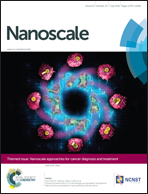Nanoparticles-cell association predicted by protein corona fingerprints†
Abstract
In a physiological environment (e.g., blood and interstitial fluids) nanoparticles (NPs) will bind proteins shaping a “protein corona” layer. The long-lived protein layer tightly bound to the NP surface is referred to as the hard corona (HC) and encodes information that controls NP bioactivity (e.g. cellular association, cellular signaling pathways, biodistribution, and toxicity). Decrypting this complex code has become a priority to predict the NP biological outcomes. Here, we use a library of 16 lipid NPs of varying size (Ø ≈ 100–250 nm) and surface chemistry (unmodified and PEGylated) to investigate the relationships between NP physicochemical properties (nanoparticle size, aggregation state and surface charge), protein corona fingerprints (PCFs), and NP-cell association. We found out that none of the NPs’ physicochemical properties alone was exclusively able to account for association with human cervical cancer cell line (HeLa). For the entire library of NPs, a total of 436 distinct serum proteins were detected. We developed a predictive-validation modeling that provides a means of assessing the relative significance of the identified corona proteins. Interestingly, a minor fraction of the HC, which consists of only 8 PCFs were identified as main promoters of NP association with HeLa cells. Remarkably, identified PCFs have several receptors with high level of expression on the plasma membrane of HeLa cells.



 Please wait while we load your content...
Please wait while we load your content...